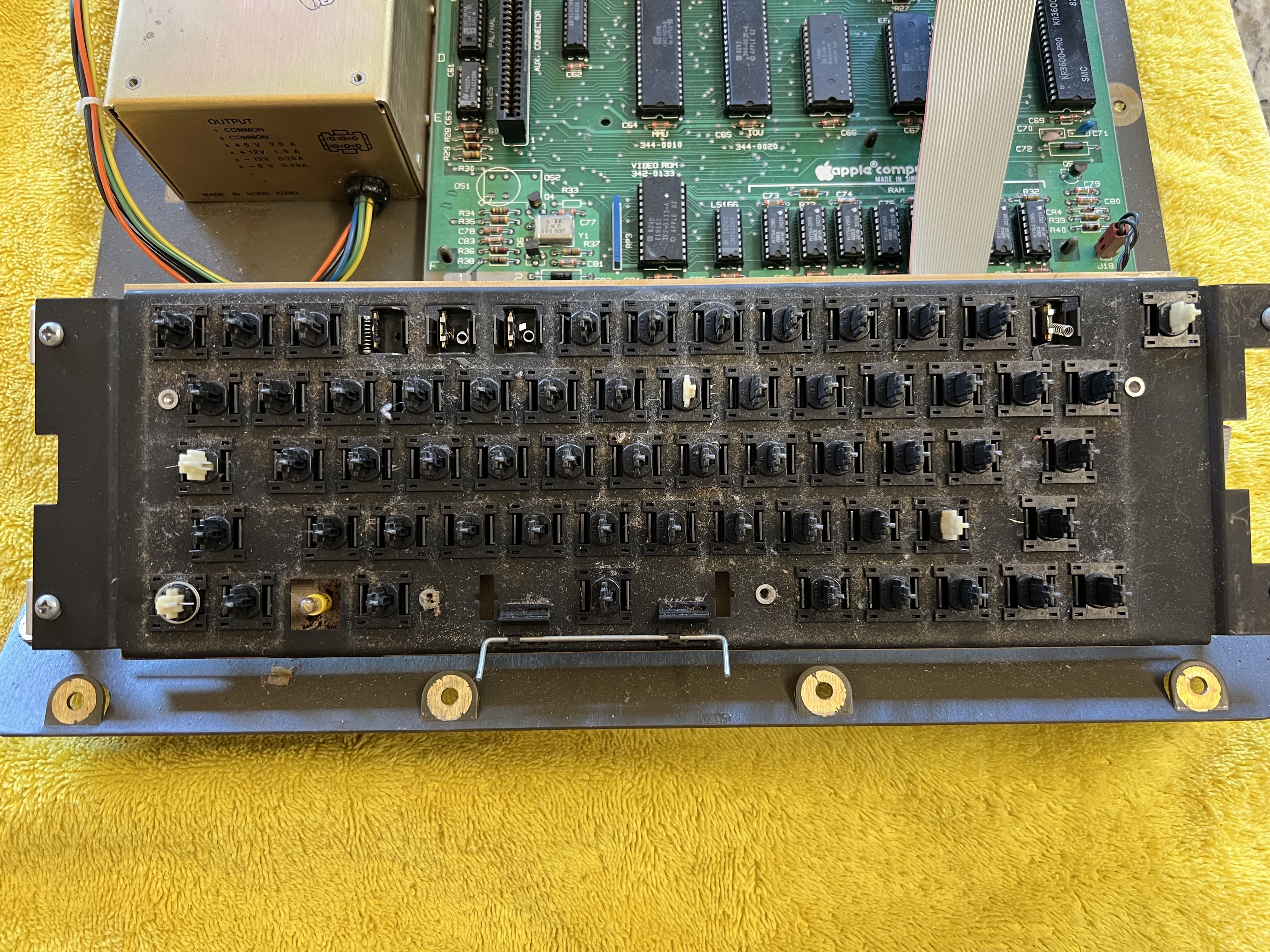I'm deep into a restoration of a really nice Apple IIe. The machine came to me in semi-rough state, with a failed power supply, lots of dirt and grime, and just generally suffering from decades of neglect. Last week I recapped the PSU (my first-ever recap job!), which seems to have immediately resolved various functional / stability problems I was seeing with the machine, so that feels great.
Other than deep-cleaning the case and motherboard, my current focus is on the keyboard. The keys were pretty gross - covered in ancient sticky gunk (I suspect someone spilled a Coke or something similar onto it ages ago) and with several that didn't respond to presses (including the Caps Lock switch). I took the system apart yesterday and ran into a few immediate challenges:
1. The keyboard cable is FUBAR, with cracks in the ribbon and both plugs having separated / fallen off. Before bed last night I impulse-purchased a colorful replacement on eBay (should arrive early next week), but I'm uncertain if I bought the wrong type. Here's the item I bought - if anyone can validate whether it will work or not, I'd be grateful!
2. The keyboard itself shows signs of having been repaired (or at least worked on) in the past. A few of the key-switch posts are cream colored while the rest are black, and the screws that hold the keyboard onto the chassis are noticeably worn. I've cleaned it as best I can, but there's a lot of sticky gunk visible in-between the PCB and the metal plate (probably residue from that long-ago soda spill). Is there a way to separate the PCB from the metal plate without having to desolder / disassemble every key-switch?
3. As mentioned above, the Caps Lock key doesn't currently work. I've sprayed a little De-Ox into the mechanism and worked it up/down a bunch of times, but I won't be able to verify if it's working until I get a good replacement ribbon cable (hopefully next week, fingers crossed). If it turns out that the Caps Lock switch still isn't working, what would be my next steps there? Replacement? Disassembly? Any guidance would be appreciated!
Thanks everyone!
Huxley





If you have a multi meter, you can check your caps lock key (or any other key) by using the continuity mode on the meter. That way you can troubleshoot while you wait for a replacement cable. Just put the meter on both pins/solder joints for the key, and actuate it. If it's good, you should hear a beep. Caps lock is easy to check yourself since it stays actuated. But a second set of hands would be really helpful to check regular keys this way.
As far as I am aware, you need to desolder the keys to seperate the metal plate and PCB. Unless you can simultaneously compress the clips of like 30 some key switches to release from the black plate. Besides, if something spilled in there, you are going to want to clean under the switches. The liquid would have most likely made its way between the switch and PCB. A vacuum solder gun makes short work of a job like this.
That existing ribbon cable will most likely still work (assuming it only broke on one end) in the short term as long as you don't try to remove it. It looks like all the pins are still piercing the ribbon cable. If you were to try and remove it, you'll pull it off the pins and then you would have to try and realign it. I can't speak to if the one you bought is proper. I believe bad things can happen (like frying the keyboard encoder) if the cable gets plugged in backward though. So making sure the connectors are orientated correctly on the new cable is critical.
You might try running the keyboard, minus keycaps through the dishwasher. Sometimes that helps a lot with spilled soda etc and it is not much effort.
While some PCBs can be run through a dishwasher, I'm not sure I would recommend running a keyboard PCB that still has key switches attached through one. I'd be too worried about water getting trapped in the switches that would take forever to dry out. Contact cleaner is made to evaporate quickly. Water stuck in a key switch could be there for a long time.
Also, if you do run any PCB through a dishwasher, never use a headed dry cycle.
Strongly agree - if I could just wash the PCB alone, I'd do it ASAP, but the switches on this one are already so fragile, I'm pretty sure that half (or more) of them would totally crumble within minutes, and I'd never find all the tiny springs and pieces that would scatter.
Given that de-soldering every individual keyswitch is unappealing at this point, I might try doing a little DIY washing using some warm distilled water carefully poured between the PCB and metal plate, and then using an air-blower on the lowest setting to dry it off...
Huxley
Hello Huxley,
Keyboards can drive you nuts. I just fully restored a ii plus keyboard, desoldered every switch off, opened every switch, deoxit every one, back together, back apart, back together, back apart, glass bead blasted the rusty steel plate. Those switches took me weeks to get them all to respond correctly, so if that iie was stored around moisture, those switches are probably all dirty. Lot of good responses I see, I honor all there suggestions. Dish washers are fantastic but I'd have to agree water getting trapped could take a while to dry out. Patience and Deoxit is really all you can do. Not sure if you mentioned if you have alps or SMK switches (they look like alps) but on each of my alps I removed the small metal clip using tweezers and slightly seperated the brass plates and eye dropped Deoxit right in between the plates, reassemble and mash that button down hard about 100 times (switch in your hands of course) and a good switch will show continuity on your multimeter when pressed.
I would use a multimeter on that cable as well. Terminal to terminal with the meter will clearly show a break in a wire. I had a disk ii that told me ever disk was write protected, checked the ribbon cable, there was a broken wire, that was it. One more FYI so you'll have more knowledge of the iie keyboard, the keyboard ROM and the AY3600 pro are the brains of that keyboard. If no characters appear, the rom is probably bad, if it types but wrong characters appear, the AY3600 is probably bad.
Good luck.
I would NOT put a keyboard with mechanical switches in the dishwasher.
Once that corrosive dish washing solution gets inside the keyswitch there is no way to get it back out without dismantling every single key switch itself.
First, the frame of the keyboard is either steel or aluminum. If it is aluminum, then maintenance is easier to perform since aluminum oxide is easily removed with acid.
Every keyswitch must be removed from the keyboard frame.
This is time consuming but it's easy to do since solder braid works well in this situation.
To fix the keyswitches, they must be desoldered and each keyswitch has to be disassembled and the contacts cleaned, dried and reassembled. No lubricants of any kind are needed. If it didn't need to be lubricated when Apple made these things, then it doesn't need to be lubricated today either.
If you have a steel keyboard frame and if it has rusted, then remove the rust and repaint the frame with flat black spraypaint. You might want to do this if your keyboard frame is aluminum.
The circuit board has a light coating of an oily substance that should be removed with isopropyl alcohol. Be careful with the light bulb on the keyboard. The connection is usually loose.
Do not mix any of these parts if you have more than one keyboard! One size does not fit all here.
If you don't want to do all of this well, then don't. I care about the completeness of my work.